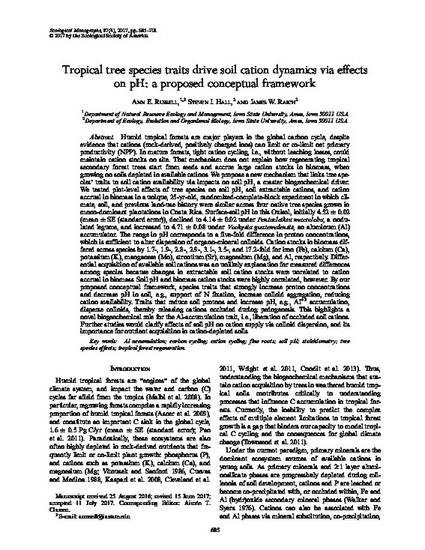
Humid tropical forests are major players in the global carbon cycle, despite evidence that cations (rock‐derived, positively charged ions) can limit or co‐limit net primary productivity (NPP). In mature forests, tight cation cycling, i.e., without leaching losses, could maintain cation stocks on site. That mechanism does not explain how regenerating tropical secondary forest trees start from seeds and accrue large cation stocks in biomass, when growing on soils depleted in available cations. We propose a new mechanism that links tree species’ traits to soil cation availability via impacts on soil pH, a master biogeochemical driver. We tested plot‐level effects of tree species on soil pH, soil extractable cations, and cation accrual in biomass in a unique, 25‐yr‐old, randomized‐complete‐block experiment in which climate, soil, and previous land‐use history were similar across four native tree species grown in mono‐dominant plantations in Costa Rica. Surface‐soil pH in this Oxisol, initially 4.52 ± 0.02 (mean ± SE (standard error)), declined to 4.14 ± 0.02 under Pentaclethra macroloba, a nodulated legume, and increased to 4.71 ± 0.08 under Vochysia guatemalensis, an aluminum (Al) accumulator. The range in pH corresponds to a five‐fold difference in proton concentrations, which is sufficient to alter dispersion of organo‐mineral colloids. Cation stocks in biomass differed across species by 1.7‐, 1.9‐, 2.8‐, 2.9‐, 3.1‐, 3.5‐, and 17.2‐fold for iron (Fe), calcium (Ca), potassium (K), manganese (Mn), strontium (Sr), magnesium (Mg), and Al, respectively. Differential acquisition of available soil cations was an unlikely explanation for measured differences among species because changes in extractable soil cation stocks were unrelated to cation accrual in biomass. Soil pH and biomass cation stocks were highly correlated, however. By our proposed conceptual framework, species traits that strongly increase proton concentrations and decrease pH in soil, e.g., support of N fixation, increase colloid aggregation, reducing cation availability. Traits that reduce soil protons and increase pH, e.g., Al+3 accumulation, disperse colloids, thereby releasing cations occluded during pedogenesis. This highlights a novel biogeochemical role for the Al‐accumulation trait, i.e., liberation of occluded soil cations. Further studies would clarify effects of soil pH on cation supply via colloid dispersion, and its importance for nutrient acquisition in cation‐depleted soils.
Available at: http://works.bepress.com/ann_russell/18/

This article is published as Russell, Ann E., Steven J. Hall, and James W. Raich. "Tropical tree species traits drive soil cation dynamics via effects on pH: a proposed conceptual framework." Ecological Monographs 87, no. 4 (2017): 685-701. doi: 10.1002/ecm.1274. Copyright by the Ecological Society of America. Posted with permission.